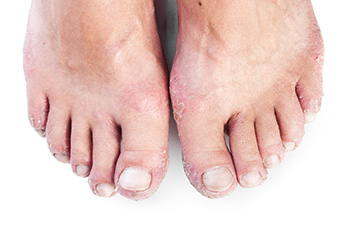
Psoriatic arthritis can cause painful and often disabling changes in the feet, toes, and ankles. Inflammation commonly develops in the small joints of the toes, leading to stiffness, swelling, and difficulty bending them or walking. Some people experience dactylitis, where an entire toe swells into a sausage-like shape. Others develop pain in the heel due to Achilles tendon involvement. Swelling in the ankles, which can restrict mobility, is also a frequent symptom of psoriatic arthritis. Over time, persistent inflammation may lead to deformities, such as clawed toes, shortening of the digits, or a flattened arch. Psoriatic arthritis can also affect the toenails, causing pitting, thickening, or discoloration, which may complicate footwear choices and performing daily activities. A podiatrist can diagnose psoriatic arthritis in the feet, recommend treatment to relieve pain and swelling, and discuss surgery if joint damage is severe. If you have symptoms of psoriatic arthritis in the feet, it is suggested that you make an appointment with a podiatrist for an exam, diagnosis, and treatment.
Arthritis can be a difficult condition to live with. If you are seeking treatment, contact one of our podiatrists from Save Your Soles. our doctors can provide the care you need to keep you pain-free and on your feet.
Arthritic Foot Care
Arthritis is a joint disorder that involves the inflammation of different joints in your body, such as those in your feet. Arthritis is often caused by a degenerative joint disease and causes mild to severe pain in all affected areas. In addition to this, swelling and stiffness in the affected joints can also be a common symptom of arthritis.
In many cases, wearing ill-fitting shoes can worsen the effects and pain of arthritis. Wearing shoes that have a lower heel and extra room can help your feet feel more comfortable. In cases of rheumatoid arthritis, the arch in your foot may become problematic. Buying shoes with proper arch support that contour to your feet can help immensely.
Alleviating Arthritic Pain
- Exercises that stretch the foot can prevent further pain and injury and increase mobility
- Most of the pain can be alleviated with anti-inflammatory drugs, heat, and topical medications
- Massages can help temporarily alleviate pain.
It is best to see your doctor for the treatment that is right for your needs and symptoms. Conditions vary, and a podiatrist can help you determine the right method of care for your feet.
If you have any questions please feel free to contact our offices located in Abington and Willow Grove, PA . We offer the newest diagnostic tools and technology to treat your foot and ankle needs.
